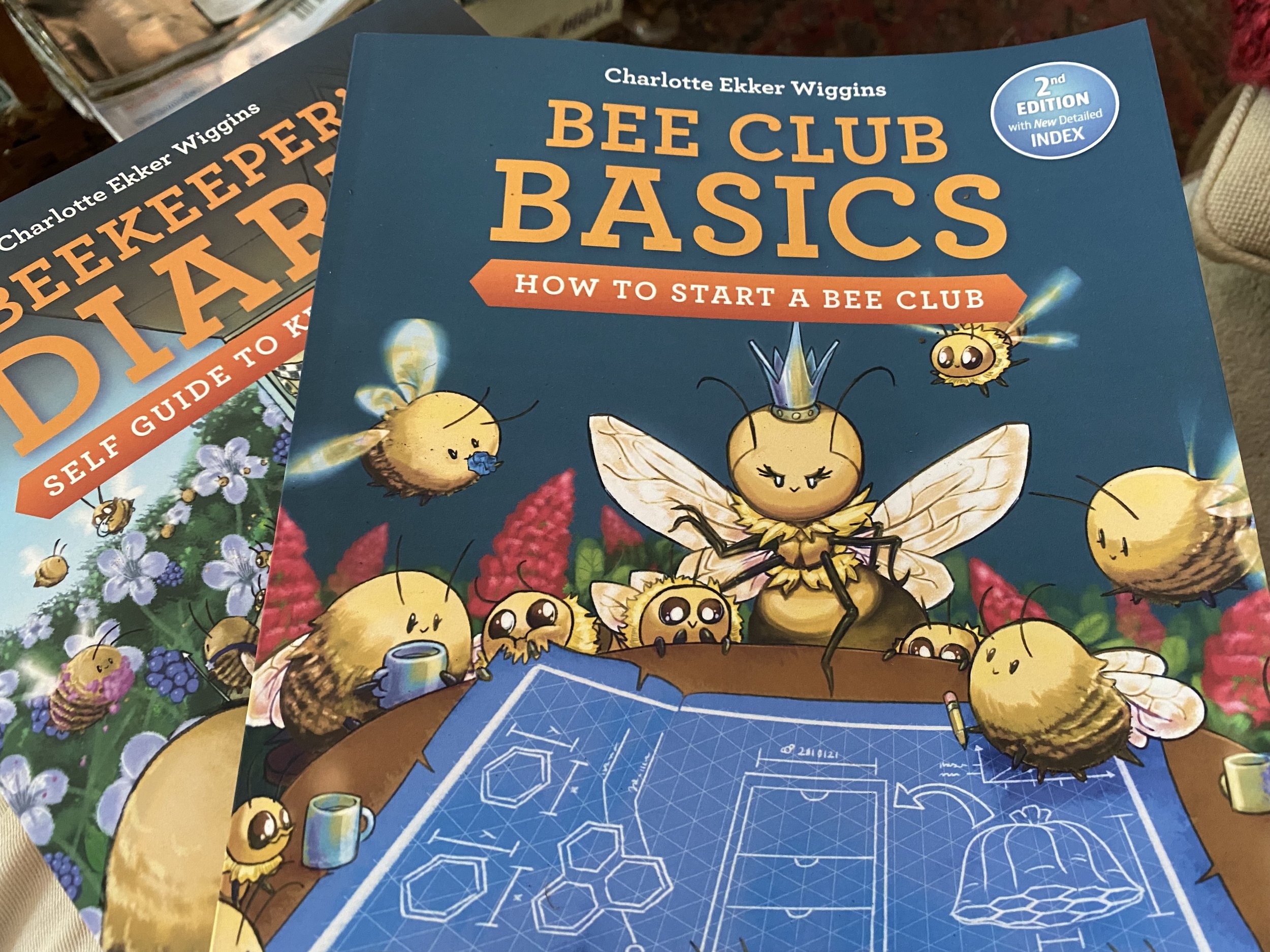Charlotte's sweet beekeeping adventures at Bluebird Gardens
Winter Bee Bars
/When honeybees aren't rummaging for pollen in bird feeder cracked corn, they like a drink of sugar water from one of my bird baths.
If honeybees didn't have access to sugar water, they would be eating stored honey so I keep their "bee bars" stocked. That way they can save eating honey for colder winter days when they can't leave their hives.
Fun to see them out and about, I miss being with my bees in winter.

Bees Corn Diving
/When winter days turn warm enough for honeybees to leave their hives, I find my girls in unusual places around my garden.
Bees make honey for winter food but if the temperatures are warm enough, they forage for pollen. My girls look for pollen wherever they can find it, especially in bird feeders.
I make my own bird seed combination including cracked corn for doves and other ground feeding birds. Apparently honeybees can find pollen in cracked corn, or at least they try hard looking for some!


A Few Dead Bees Already
/First Winter Hive Check
/It's been a very mercurial fall 2014, one day sunny in the 70s, the next day overcast and 30F. Record cold temperatures and snow followed, leaving my honeybees with little time to get themselves acclimated to weather changes.
Bees cluster to keep warm through winter. During days with temperatures less than 40F, they stay inside the hive, huddled together to keep the queen, and themselves, warm.
The entrance to the hive is closed down to a one bee width, assuming snow hasn't covered it up.
Although snow can be an insulator, it also can also seal the entrance closed as it melts, keeping bees from taking their cleansing flights. Time to do a little snow removal!
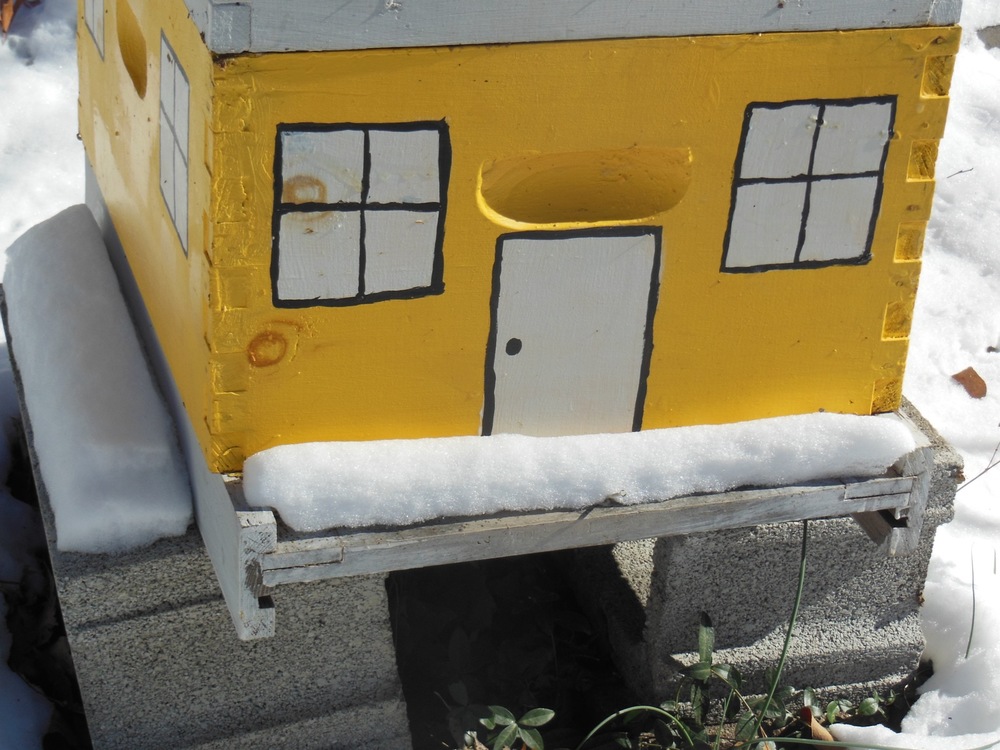
Sugar Water Fly Through
/Looking for Live Bees
/One of HomeSweetBees.com readers contacted me about getting 30-40 bees a week for therapy for a bad back.
Bee Stings For Arthritis
Although it has not been scientifically proven, some people say applying bees to a certain area of the body helps with arthritis and other medical conditions. Most beehives in Missouri are at their lowest numbers through winter. Beekeepers are not going to open a hive, and expose it to moisture and cold weather, to remove just 30-40 bees a week. Bees form a ball in the center of the hive and make it through winter literally shivering themselves warm. Although a worker bee may only live for 4-6 weeks during summer, worker bees over winter may live as long as 6 months to get the colony from one season to the next.
Personal Observation Hive
Experienced beekeepers tell me people who need bee stings for on-going therapy usually set up an "observation hive," or a hive that's inside with a vent access to the outside so beekeepers can more easily get to, and remove, the needed quantity of honeybees.
Sorry, all of my honeybees are adopted!
Charlotte
To Brush or Not to Brush
/
It's easy to spot the new beekeepers at a meeting because within minutes they have that "lost" look on their faces. Beekeepers, like any other specialty, have their own language and shorthand when discussing issues.
To better familiarize myself with the "beekeepers'" language, I read as many books as I could, focusing on the terms. I will go over some of the more common terms and tools here because they are as much a reflection of the profession as - well, reading a book!
Bee Brushes
One of the beekeeper's more controversial tools is the "bee brush." Looking like a giant yellow toothbrush, the bee brush has very soft bristles and a long handle for easy gripping. Bee brushes are handy to have if you don't want to hurt or kill bees as you move hive pieces around. Honeybees in a garden are so intent on their work, they often will continue working without realizing their hive frame has been moved, or the top is on the side of the hive. Bees will follow the queen so even though you may be moving bees around, they will all try to climb back into the hive after the queen.
How to Use Bee Brush
To make sure you don't kill or harm bees, slowly move the bee brush across the area where you want bees to leave. And I mean S-L-O-W-L-Y, you are using the bee brush bristles to nudge the bees along, not sweep them off their feet. I like having my bee brush with me when I open hives, even just to inspect. I can more easily guide bees away from areas that may otherwise hurt them as I move frames around or put the top back on.
Don't want to use a bee brush? It also makes a nice tool to brush furniture treated with beeswax!
To the Little Busy Bee
/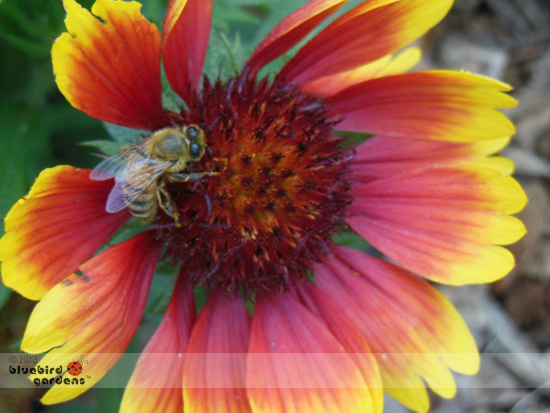 "How doth the little busy bee, improve each shining hour, and gather honey all the day from every opening flower!" — Isaac Watts 1674-1748
"How doth the little busy bee, improve each shining hour, and gather honey all the day from every opening flower!" — Isaac Watts 1674-1748
Scientists now know various pollinators have a preference for different-colored flowers. Honeybees, for example, are attracted to yellow and blue flowers; hummingbirds and butterflies to pink and purple ones.
Although honeybees have a preference, I have also found honeybees on pink, red, and purple flowers, especially mid-summer when little else was in bloom. Flowers will stop producing pollen when temperatures go above 90°F, leaving honeybees with limited pollen sources to take back to the hive.
Would You Like a Bite?
/
Thanks to the tons of money being invested in finding out more about the little insect responsible for every third bite of food we eat, there are now regular scientific discoveries made about honeybees. One recent discovery was news even to many beekeepers, who used to describe this behavior as "grooming."
Honeybees Don't Just Sting
Turns out honeybees aren't being fashionable or fastidious; they not only sting but they can also bite. I wondered what some of my bees were doing earlier this summer when I opened a hive to find them "rolling" a wax moth larvae away from the hive entrance. I had read that healthy hives can protect themselves from these invaders and assumed bees were stinging the larvae. After several bees converged on the wax moth larvae, I noticed none of the bees were dying.
A bee can only sting once, then dies.
Although the bees were still moving, the wax moth larvae had stopped. The bees were then able to roll it off the edge of the hive. Now I know the bees were biting the wax moth larvae. Researchers have discovered that honeybees use their tiny mandibles to paralyze victims with a snake-like venom. The secretion left by the bite was found to be similar to Lidocaine, the dominant local anesthetic used in humans and other mammals. Like a snake bite, the secretion contains a natural anesthetic that paralyzes the victim for 6-10 minutes so the pest can be dragged out of the hive. The finding could help scientists develop ways to help bees fight off viruses that are affecting the wider bee population.
Bee Anesthetic
Dr Max Watkins, a former researcher at Cardiff University, said the anesthetic may not only help honeybees fend off pests such as wax moths and the parasitic varroa mites, but it also has great potential for human use.
“Firstly, the revelation that honeybees can bite enemies that they cannot sting confounds some existing ideas and adds significantly to our biological knowledge. “Secondly, the discovery of a highly effective natural anesthetic with huge potential will be of great interest to the pharmaceutical industry eager to develop better local anesthetics.”
The natural anesthetic is 2-heptanone, a compound found in many foods.
It is also secreted by certain insects but never before understood to have anesthetic properties. Until recently, research seemed to indicate that 2-heptanone was either a honeybee alarm pheromone that triggers defensive responses, or a chemical marker signaling to other foraging bees that a flower had already been visited. The compound is found naturally in many foods such as beer and white bread, and is so safe that USDA allows it as a food additive.
That's a bear of a discovery!
Charlotte
Baa Baa, Bee!
/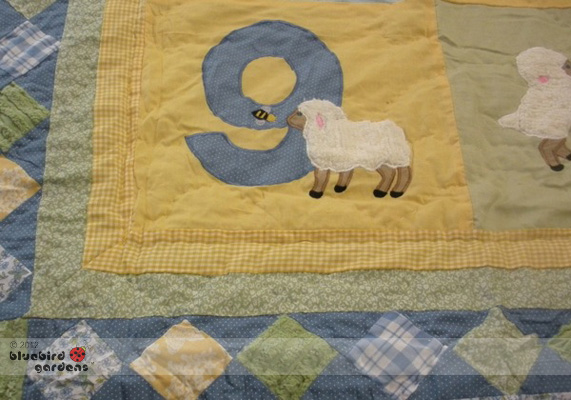
I have to confess, I now look for bees in everything.
This charming One Sheep Two Sheep baby quilt already had a bee. I didn't notice it until I was photographing the quilt.
Looks like the sheep was noticing it for the first time, too!
Charlotte
Pool Party
/
Honeybees sometimes run out of places to store honey. When that happens, they will add wax comb between hive floors.
When the hive is opened, that exposes little extra honey pools and bees dive right in!
Charlotte
What's On a Honey Label
/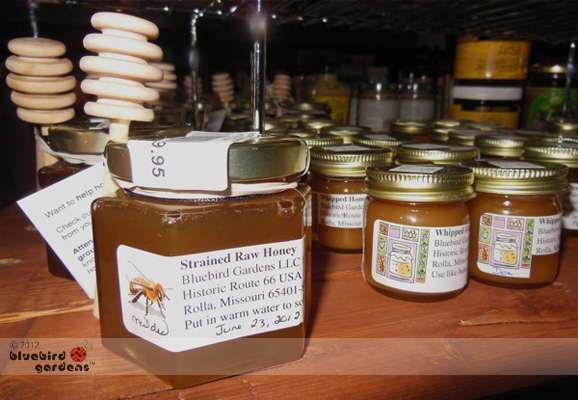
Bluebird Gardens honey is just as it comes out of the hive. Actually, the labels include which hive.
In this case, it's bees from Mildred hive, named after my grandmother. It was harvested by hand June 23, 2012.
It hasn't been mixed or had artificial flavorings added.
If honey gets cloudy, put in warm water to clear. No need to refrigerate, honey can last literally for centuries.
Charlotte
Happy Spring!
/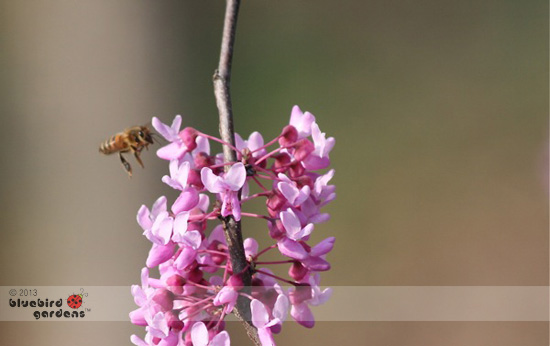
"I love spring anywhere, but if I could choose I would always greet it in a garden." --Ruth Stout
Charlotte
Bee Necklace
/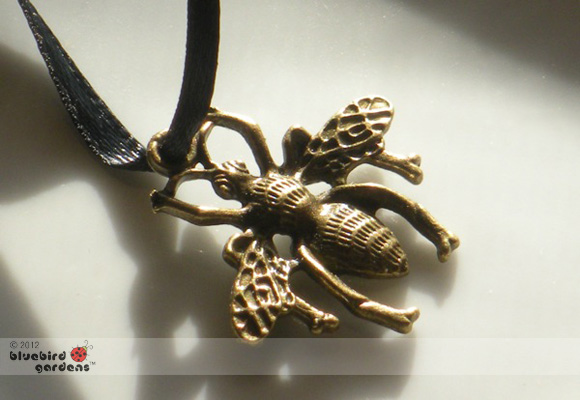
Connie at Nature Girls was eyeing my latest glass jars full of honey.
Besides an informational tag, I had added a little bee charm.
These sure would make a nice necklace, she said as she peered at me over her glasses. Earrings, too.
Next time I stopped in, I left her some extra bee charms.
No honey jars attached.
Charlotte
Bee-ing Neighborly
/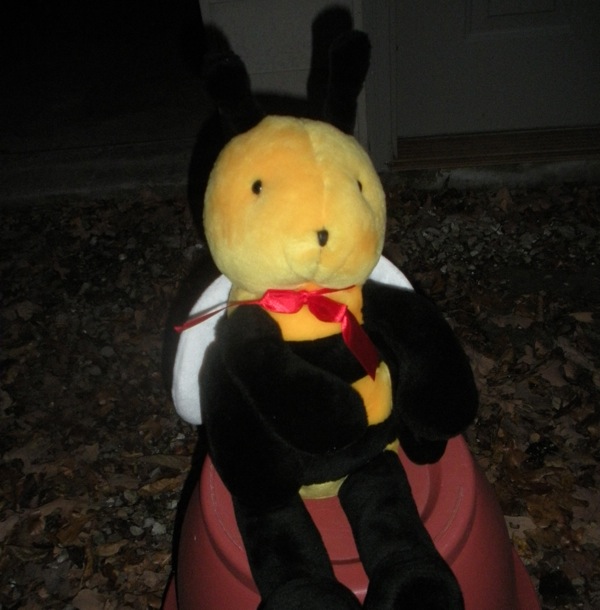
I came home one night to find this big girl sitting on a flower pot in my driveway.
My lovely neighbor Elaine had cleaned out her daughter's closet. Knowing I have bees, she thought this stuffed bee belonged with me.
The bee now marks the entrance to beekeeping club meetings. Fun to bring her along!
Charlotte
Marking the Queen
/
One of the challenges of beekeeping is finding the one, very important queen in a hive.
Fellow Fort Leonard Wood Beekeeper Cheryl decided to mark her queens with these magic makers. She captures the queen in the blue jar, then adds a dot with the sponge on the queen's back.
It would be so much easier if the queen was more like the little princesses I know and wore a teeny tiny tiara.
Charlotte
Cleaning House
/
Honeybees are very fastidious. They like to keep the hive clean.
As the 2012 summer drought continued, baby bees died in the nursery because bees couldn't find pollen.
When temperatures are over 90F for any length of time, flowers shut down to survive and stop producing pollen.
Worker bees removed the little mummy-like bodies and left them on the hive deck. Sad to see but relatively harmless to the rest of the colony
Charlotte
Kissing Cousins
/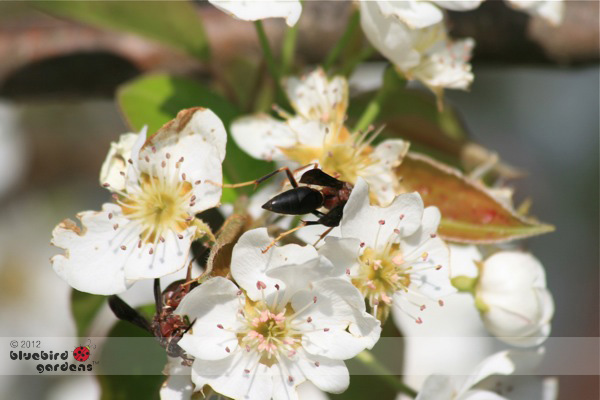
Yellow jackets and bees are not the same.
Millions of years ago, wasps and bees were the same species.
No one knows why bees became vegetarian and started to make honey. Both are important garden pollinators.
Before I had honeybees, I had a healthy population of wasps pollinating my compact pear tree.
Charlotte











